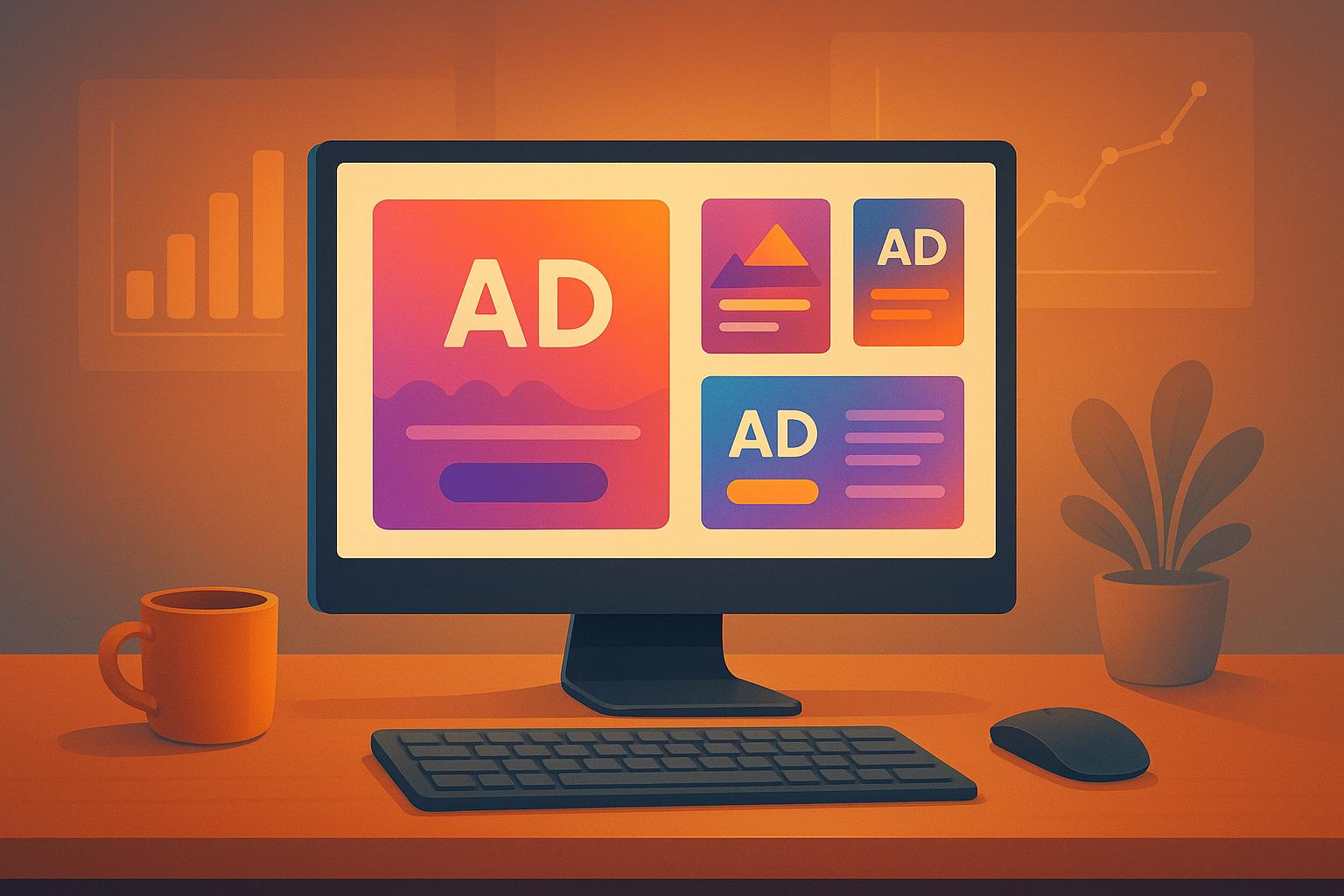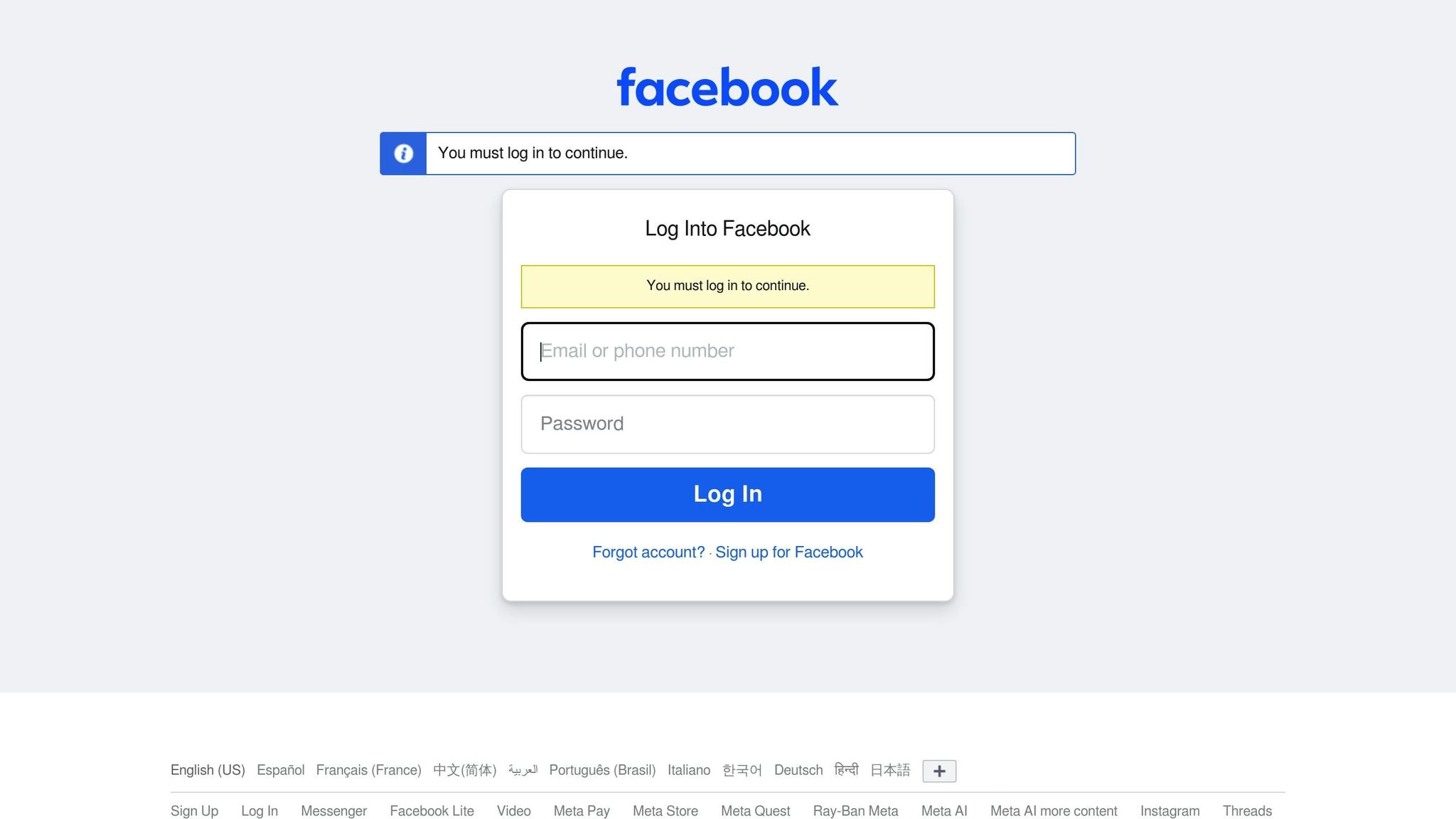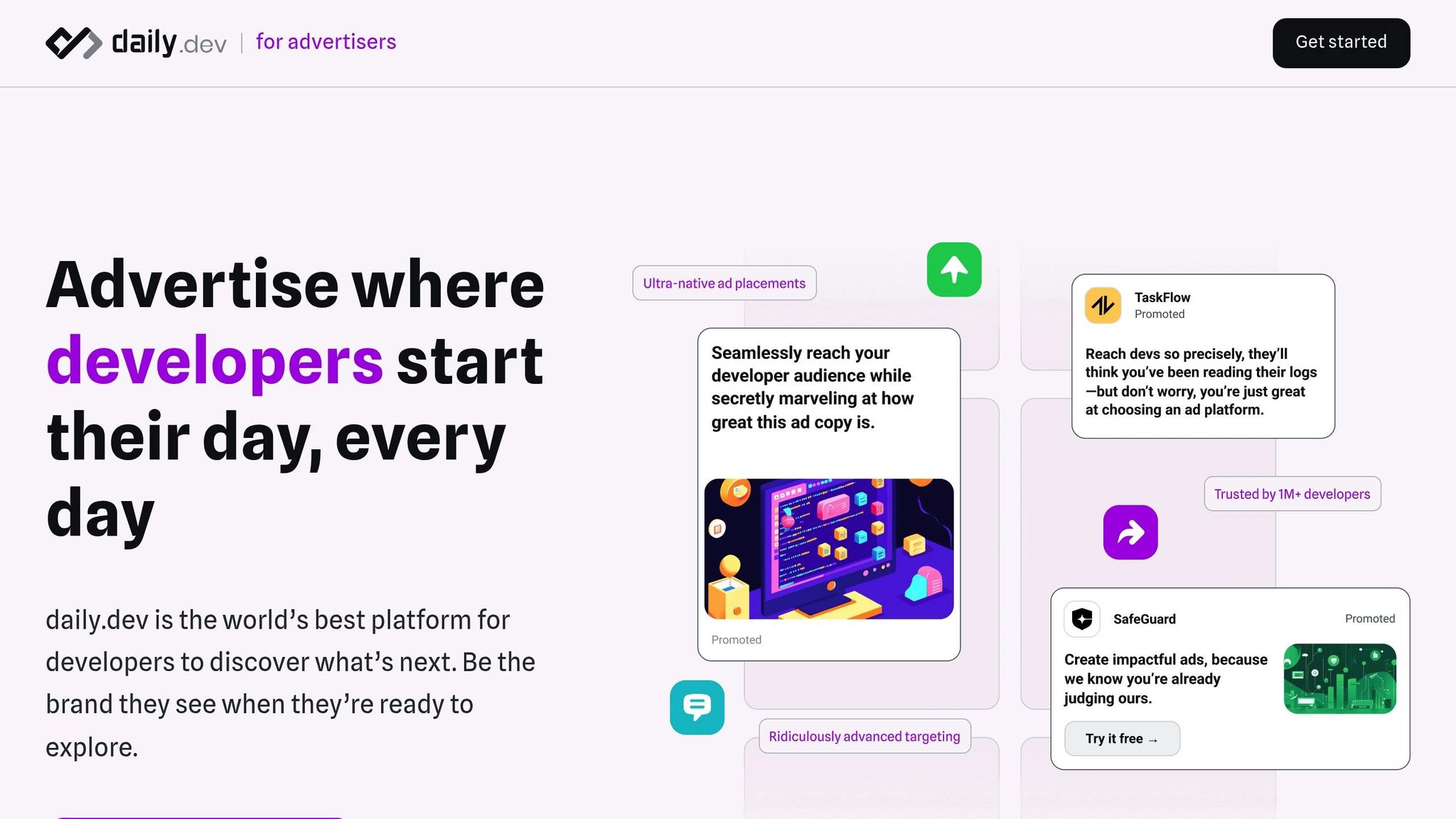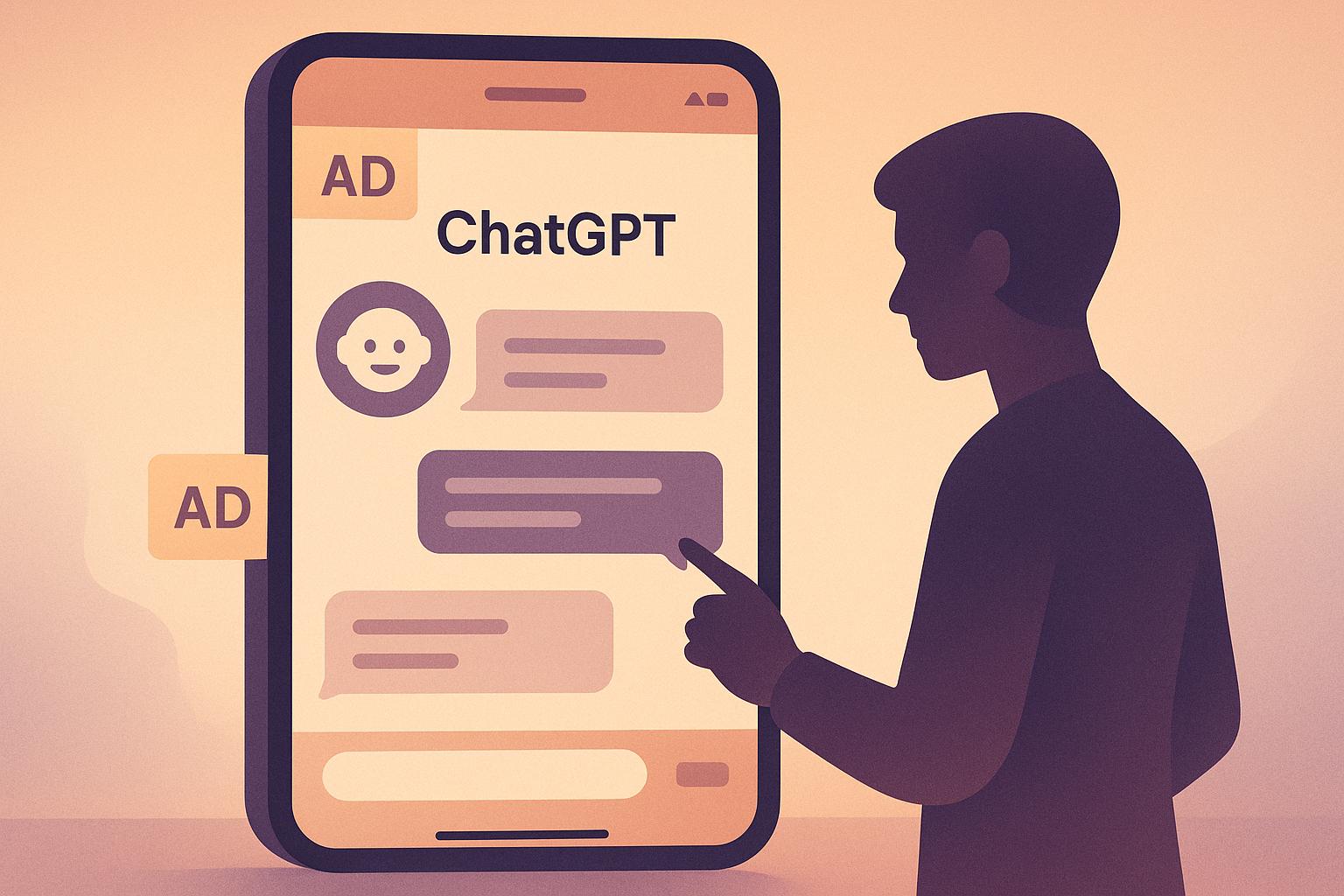


Unlock the power of real-time ad creative testing to optimize your campaigns instantly, maximizing engagement and conversion rates.
Real-time ad creative testing is all about making quick, data-driven adjustments to your ad campaigns while they’re live. Instead of waiting for traditional A/B testing results, this method gives you immediate insights so you can optimize as you go. Here’s the key takeaway: you can improve your ads in real time to boost results like clicks, conversions, and engagement.
Why It Matters:
- Instant Feedback: Quickly identify what works and what doesn’t.
- Adapt to Trends: React to audience behavior and market changes immediately.
- Save Resources: Focus on high-performing ads and cut underperformers fast.
How It Works:
- Set Goals: Define clear objectives like increasing sign-ups or driving traffic.
- Choose Variables: Test elements like visuals, headlines, CTAs, or audience segments.
- Use the Right Tools: Platforms like daily.dev Ads offer real-time tracking and targeting options.
- Track Metrics: Focus on measurable outcomes like CTR, CPA, and ROAS.
By testing in live conditions and analyzing performance data as it happens, you can make smarter decisions and maximize your ad budget. Whether you’re running seasonal promotions or targeting niche audiences, real-time testing ensures your ads stay relevant and effective.
How to (logically) test Facebook Ads at an incredible speed

Setting Up a Real-Time Testing Framework
Creating a real-time testing framework starts with careful planning and the right tools. These steps lay the groundwork for fine-tuning your creative elements effectively.
Defining Goals and Testing Variables
The first step in setting up your testing framework is to establish specific, measurable goals. Instead of vague objectives like "improve performance", focus on clear targets - whether it's increasing product adoption, driving brand awareness, boosting event attendance, generating qualified leads, or growing website traffic. These goals will guide the testing variables you need to track.
Next, pinpoint the variables that directly influence these goals. Prioritize elements you can adjust in real time without disrupting your overall campaign.
One of the most impactful areas to test is audience targeting. For example, you can explore different audience segments based on factors like seniority (e.g., Aspiring, Entry-Level, Mid-Level, or Senior Engineers), preferred programming languages (e.g., JavaScript, Python, Java, Swift, or Go), or favorite tools (e.g., Docker, Kubernetes, Jenkins, or Visual Studio Code). You might also experiment with hyper-local geographic targeting for more refined results.
Ad placement is another key variable. Comparing performance across placements - like in-feed native ads versus post-page ads - can reveal where your audience engages most effectively.
Finally, test creative elements, but focus on the ones most likely to make an impact. Start with one or two high-priority variables. Testing too many elements at once can muddy the results, making it harder to identify what’s driving success.
Choosing the Right Testing Method
Deciding between A/B testing and multivariate testing depends on your campaign goals, traffic volume, and available resources.
- A/B testing is ideal for evaluating a single change and works well when traffic is limited.
- Multivariate testing lets you analyze how multiple factors interact but requires higher traffic and longer testing periods to produce reliable data.
Platforms like daily.dev Ads simplify real-time tracking and optimization for both methods. While A/B testing is quicker and easier to implement, multivariate testing can provide deeper insights into how different elements work together. For more complex campaigns, consider consulting experts for tailored advice. Daily.dev Ads also offers advanced targeting options, ensuring your creative variations are tested with the most relevant developer groups. Once you select a testing method, define clear metrics to measure success.
Setting Performance Metrics
Choose metrics that directly align with your business goals and avoid vanity metrics. For example:
- Product adoption: Track sign-ups and conversions.
- Brand awareness: Focus on impressions and reach.
- Event performance: Measure registrations and attendance.
Additionally, evaluate cost efficiency through metrics like CPA (Cost Per Acquisition) and ROAS (Return on Ad Spend).
Engagement metrics, such as click-through rate (CTR) and overall engagement rate, are early indicators of creative performance. With real-time data, you can quickly adjust your approach, ensuring every metric contributes to better outcomes. This instant feedback helps you spot trends, fix issues, and double down on strategies that work.
Finally, set realistic benchmarks based on industry standards and your past performance. Even small gains - like a 10% rise in CTR or a 5% drop in CPA - can add up significantly over time, driving meaningful long-term results.
Key Creative Elements to Test
Once your real-time testing framework is in place and aligned with your goals and metrics, it's time to focus on the creative elements that influence performance. daily.dev Ads offers expert creative advice and real-time tracking to help fine-tune your strategy and identify what resonates most with your audience.
Visuals and Design
The way your ad looks can make or break its performance. A strong visual design boosts visibility, encourages engagement, and builds trust with developers. Ads that feel natural and blend seamlessly into the platform's feed tend to perform better. With daily.dev Ads, you can get tailored creative guidance to ensure your visuals strike the right chord with your audience.
Ad Copy and Messaging
Your ad copy should reflect your brand while speaking directly to developers. Headlines and messaging that match the platform's tone and style are more likely to connect. Using daily.dev Ads' expert insights and real-time feedback, you can tweak your copy throughout the campaign to better align with your audience's preferences.
Call-to-Action Optimization
A clear and compelling call-to-action (CTA) is key to turning interest into action. Use real-time analytics to track how users engage with your CTAs and adjust them as needed for better results. These tweaks not only enhance your ad's effectiveness but also lay the groundwork for the strategies and tools discussed in the next section.
Best Practices for Effective Real-Time Testing
Creating a reliable real-time testing framework means focusing on practices that cut out guesswork and ensure accuracy. These steps will help you design a testing process that produces insights you can count on.
Testing One Variable at a Time
The golden rule of real-time testing? Stick to one variable at a time. If you change multiple elements - like a headline and an image - at once, it’s almost impossible to tell which tweak made the difference. By isolating a single creative element in each test (for instance, starting with headline variations, then moving on to call-to-action buttons using the top-performing headline), you’ll get clear, actionable data about what actually resonates with your audience.
With tools like daily.dev Ads, you can track real-time performance for self-serve campaigns, making it easy to see how small, single-variable changes affect your results in real time. For more complex testing scenarios, their expert consultation services can help you prioritize variables systematically.
Preventing Audience Fatigue
Showing the same creative too often can lead to audience fatigue, where users lose interest or engagement drops. Keep an eye on your campaign’s engagement metrics and adjust the frequency of your creative to maintain audience interest and avoid overexposure.
Testing in Live Campaign Conditions
If you want results that reflect how your audience truly behaves, testing in live campaign conditions is non-negotiable. This means running your tests with the same targeting, placements, and settings you plan to use in your full launch. Simulating the actual environment ensures your results are as accurate and relevant as possible.
"The ideal platform reaches developers when they're in discovery mode - on desktop, during work hours, with hyper-targeted, relevant ads. That's exactly what daily.dev offers." – Nimrod Kramer
daily.dev Ads makes live testing seamless with precision targeting options like seniority level, programming languages, and developer tools. Their hyper-native ad placements - such as in-feed native ads and post page ads - blend smoothly into the user experience, ensuring your tests feel natural and unobtrusive. Plus, their real-time analytics dashboards let you monitor performance on the fly, so you can quickly identify what’s working and scale up successful creatives. Afterward, you can use technology and automation to fine-tune your approach even further.
sbb-itb-e54ba74
Using Technology for Real-Time Testing
Technology makes it possible to make quick, informed decisions during live campaigns. With real-time tracking, you can evaluate how well your creative content is performing and make adjustments on the fly. This approach builds on earlier strategies by allowing you to refine your creatives as the campaign unfolds.
How daily.dev Ads Supports Real-Time Testing

daily.dev Ads simplifies the testing process by offering built-in real-time performance tracking. This instant feedback allows you to quickly identify which creative variations are resonating with your audience.
The platform’s precise targeting tools ensure your creative variations consistently reach the right audience - developers. It does this by focusing on factors like programming languages, seniority levels, and tools. On top of that, hyper-native ad placements - such as in-feed ads, post page ads, and personalized digest ads - position your creatives in trusted, relevant spaces.
For campaigns with budgets of $5,000 or more, the self-serve option provides direct access to integrated tracking tools. Whether your goal is driving product adoption or generating leads, this setup helps optimize your creatives to align with your business objectives.
Overcoming Common Testing Challenges
Testing in real-time often comes with hurdles that can impact both results and budgets. Identifying these challenges early allows for practical solutions that keep your efforts on track. Let’s look at some common testing obstacles and how to tackle them effectively.
Managing Small Sample Sizes
When your audience is too small, the results can lack reliability and fail to reach statistical significance. To address this, consider extending your testing period to gather more data. You can also expand your targeting criteria to include a broader audience while maintaining relevance. For example, developer campaigns can benefit from platforms like daily.dev Ads, which connects with over 1,000,000 developers worldwide.
Accounting for External Factors
Market shifts, seasonal changes, and unexpected events can distort your testing outcomes. Using real-time tracking and hyper-local segmentation can help you identify and isolate these variables. With tools like daily.dev Ads, you can access instant performance feedback, making it easier to adjust and refine your efforts as needed.
Working with Limited Resources
Limited budgets and small teams can make testing feel like a daunting task. To make the most of your resources, focus on tests that are likely to deliver meaningful insights and improvements. Expert creative guidance can also help you avoid expensive missteps. Additionally, platforms like daily.dev Ads offer precise targeting, ensuring your tests reach the right audience without wasting resources.
Scaling and Optimizing Your Testing Program
Once you've tackled the initial challenges of real-time testing, the next step is creating a program that can grow alongside your needs. Scaling isn't just about running more tests - it’s about maintaining quality while expanding your efforts in a structured way.
Improving Winning Creatives
Your most successful creatives are treasure troves of insights that can fuel future iterations. When a creative performs well, dive into the details to understand why. Was it the color scheme, the tone of the messaging, or the layout that resonated? Pinpoint these winning elements and use them as a foundation for new variations.
Instead of retiring high-performing ads, build upon them. For instance, if a headline is driving strong engagement, experiment with different supporting copy while keeping the headline intact. This approach allows you to refine and evolve your strategy without starting from scratch each time.
With expert creative input, you can apply these insights more systematically across your campaigns. Think of your winning creatives as starting points rather than endpoints. Each test provides valuable data that feeds into the next, creating a cycle of continuous improvement. Over time, this iterative process supports the strategic planning necessary for sustained success.
Creating a Long-Term Testing Plan
To scale effectively, you need a clear roadmap. Begin by outlining your testing priorities for the next 6–12 months, ensuring they align with your broader marketing goals and upcoming product launches. This roadmap should also reflect the performance metrics you've previously established.
Consider seasonal trends, audience growth opportunities, and experimenting with new creative formats. For example, if you're targeting developers, you might adjust your messaging during major conference seasons or tweak your approach as tech trends shift. Plan regular review periods - monthly or quarterly - to assess results and recalibrate your priorities.
Scaling your program also means accounting for resources. As your testing efforts grow, so will the demands on your budget and team. Platforms like daily.dev Ads offer entry points with a $5,000 minimum spend, and first-time advertisers can get $500 in ad credit when spending $2,000. Use a centralized testing calendar to document everything, ensuring your team stays aligned, avoids redundant tests, and has clear visibility into upcoming priorities. A well-organized roadmap not only keeps your team on track but also sets the stage for efficient automation.
Using Automation to Scale Testing
When you’re scaling, manual testing quickly becomes impractical. Automation is key to managing a larger program without sacrificing precision. By building on clearly defined goals and metrics, automation can handle repetitive tasks like launching tests, collecting data, and flagging noteworthy results, freeing you to focus on strategy and creative refinement.
Self-serve platforms with real-time tracking allow you to run multiple tests simultaneously without the need for constant manual intervention. Automated tools ensure consistency by managing test durations, achieving statistical significance, and adhering to your success criteria. While automation reduces human error, regular oversight remains essential. Set up alerts for major performance shifts and routinely review results to fine-tune your approach.
"The ideal platform reaches developers when they're in discovery mode - on desktop, during work hours, with hyper-targeted, relevant ads. That's exactly what daily.dev offers." – Nimrod Kramer, May 20, 2025
The ultimate goal is to create a testing system that runs smoothly and provides actionable insights, enabling you to make smarter, more informed creative decisions.
Conclusion
Real-time ad creative testing has transformed the way campaigns are optimized, offering immediate insights that allow for quick adjustments. This method lets you fine-tune your messaging, visuals, and targeting on the fly, helping you better align your ads with your business goals.
By leveraging these insights, you can maximize the impact of your campaigns. Testing creative elements in real time ensures your ads connect with the right audience at the right moment, delivering messages that truly resonate. When combined with precise targeting and well-placed ads, this approach ensures your efforts consistently hit the mark.
For campaigns aimed at developers, daily.dev Ads stands out by offering precise targeting options based on factors like seniority, programming languages, and tools. Its built-in analytics give you the ability to track performance in real time, enabling immediate, data-driven adjustments. This creates a feedback loop of continual improvement, as highlighted throughout this guide.
Real-time testing also helps optimize your budget by scaling up successful ads quickly and reducing spend on those that underperform. This is especially important for brand awareness campaigns, where efficient use of resources directly influences your ability to engage your audience effectively.
FAQs
What makes real-time ad creative testing different from traditional A/B testing, and why is it beneficial?
Real-time ad creative testing takes a different approach from traditional A/B testing by letting you tweak your ads as they perform, rather than waiting for an entire test cycle to finish. This means you can make changes in the moment, saving time and boosting the efficiency of your campaigns.
With this method, your ad budget is used more wisely, as it helps pinpoint and expand the reach of top-performing creatives faster. By tapping into live performance data, you can adapt quickly to audience behavior, driving better engagement and stronger results.
What are the key steps to set up a real-time ad creative testing framework for accurate and actionable insights?
To build a solid framework for real-time ad creative testing, start by setting specific goals. Decide what you’re aiming to measure - whether it’s click-through rates, conversions, or engagement levels. Having clear objectives will guide every step of your testing process.
Next, create a structured testing environment. This could involve A/B testing (comparing two versions of an ad) or multivariate testing (examining multiple elements at once). The key is to test under controlled conditions so you can pinpoint what works and what doesn’t.
Consider using platforms like daily.dev Ads. This platform is specifically designed to reach developers, letting you test your ads with a highly targeted audience. Track performance metrics in real time and use this data to tweak and improve your campaigns.
Keep your tests focused - don’t overwhelm the process by testing too many variables at once. This way, you’ll get clear, actionable insights to refine your ad strategy.
How does daily.dev Ads improve ad performance with real-time testing, and what features make it ideal for targeting developers?
daily.dev Ads boosts ad performance by offering real-time testing and precise targeting designed specifically for developers. With this platform, businesses can tailor their outreach by targeting developers based on seniority levels, programming languages, and preferred tools. This ensures ads are shown to the right audience at the right time.
By addressing the specific interests and needs of developers, daily.dev Ads helps businesses drive better engagement and gain visibility within a trusted community of tech professionals.






